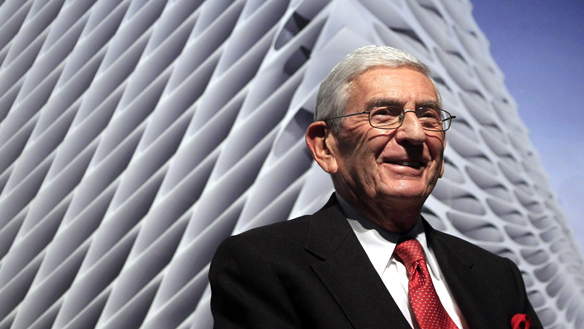
Eli Broad at the unveiling of the Broad Art Foundation contemporary art museum designs in Los Angeles on Thursday. Photo: Jae C. Hong.
Eli Broad, Los Angeles’s most aggressive philanthropist, nearly always wears solid, primary colored ties. Last Thursday, he wore a red one to unveil the plan for his new museum on Grand Avenue in downtown L.A. It stood out nicely against the projected images of the honeycomb-like building that will be situated beside Gehry’s Disney Concert Hall, which Broad largely funded, and across the street from the Museum of Contemporary Art (MoCA), which Broad helped found in the late 1970s and saved from financial ruin just a year and a half ago. Designed by New York firm Diller Scofidio +Renfro, the Broad Museum will cost approximately $1,140 per square-foot, or $130 million total. It will house Broad’s mammoth collection of work by Koons, Rauschenberg, and Johns, among others, as well as rotating, curated exhibitions. MoCA members will receive free admission.
It was Taft Schreiber, an MCA executive, who first roped Broad into art collecting in the 1970s, though Broad’s wife, Edye, already owned a Braque print, among other gems (she’d wanted to snatch up a Warhol soup can, but was afraid her husband would think she’d gone crazy). Schreiber, an art maven with a collection of de Koonings, Giacomettis, and Pollocks, had intended to make Broad a Republican, but instead made him a connoisseur of 20th century pop and abstraction–or a connoisseur of sorts. “Eli would ask everybody who was informed what their opinion was,” former Broad Foundation curator Shelley D’Angelus told the New Yorker‘s Connie Bruck, “and [he] put together his world view based on that. That’s what a good CEO does.”
Broad’s worldview is now represented by the Broad Contemporary on LACMA’s campus, the Eli and Edythe Broad Art Museum at Michigan State University (Michael Rush was recently named director), and the Broad Stage in Santa Monica, among too many other venues. But downtown is special to Broad, and this new museum, the biggest and most prominent yet, will continue that “destination-making” process he began years ago. L.A. Times architecture critic Christopher Hawthorne has criticized the museum’s design as being ill-suited to actual art–“The Romantic, 19th century Beaux Arts ideal of sky-lighted art galleries has unfortunately guided the design program of a building intended for 20th and 21st century art,” he wrote–but this only reinforces the fact that art is a secondary point. Broad mostly wants L.A. to be the world’s art capital and Bunker Hill–the once-distinguished, later desolate and finally rehabilitated incline with Grand Avenue at its crest–to be the city’s cultural corridor. Ideally, a world renowned cultural corridor.
When Broad helped found MoCA years ago, he said he didn’t want it to be “provincial.” He wanted a museum that could “overfly New York.” He’s said something to that effect in almost every art-related press conference he’s given since. A favorite point of his is that civilizations are remembered not for their business men, but for their artists, and he most wants to show up the “civilization” of New York. Bunker Hill will be our Central Park, our Champs-Élysées, Broad has said. Though Christopher Hawthorne suspects, “he may actually regret . . . comparing Grand Avenue to Paris”—Champs-Élysées is the priciest stretch in France, certainly not the “populist” environment Broad purports to champion.
Weirdly, even if Broad does regret using them as a point of comparison, the French are immensely interested in Eli and his ventures, or so says journalist Coralie Garandeau. Last spring, she spoke with L.A. Public Radio’s Frances Anderton about a feature she had begun on Broad. The French knew his name from the Kaufman and Broad tract homes he used to make his fortune, so his presence as an arts and architecture patron seemed intriguingly incongruous. Said Garandeau,
We started our research by looking at a map, and we saw on this map many places where the buildings had the Broad name on them. We though . . . Is there anyone else who would put his print on Los Angeles like him? For Europe where the state is very much implied…in all these artistic choices . . . You need competitions and you need many rules. . . There would be a comparison only for presidents. Like, we say in France that Mitterrand, President Mitterrand, he put his brand on Paris. But Mitterand was president. By the fact that [Broad is] so rich he can reverse the whole game of democracy and make his own rules. And maybe that reveals culture in America to us.
Though does it reveal our culture?
Elliott Hundley, "Some Poured Leaves Over the Dead Girl," 2009. Photo: Joshua White. Courtesy Regen Projects, Los Angeles.
I remember visiting a gallery a few years back. Broad’s chauffeur driven car was outside and inside, he was walking around with a curator, looking at large-scale collages by Elliott Hundley, whose approach to storytelling is as opulent as it is fugitive. At one point, he tapped a work on its backside. “Is this particle board?” he asked suspiciously, then wondered aloud how the works could possibly be archival. I don’t know whether he ever came around to Hundley’s project–I hope so. But, whether he did or not, Hundley remains an L.A. artist who, though he exists in a relatively specific niche, will probably have more sway over what artmakers actually do or think about than Broad ever will. So maybe the billionaire hasn’t bucked democracy.